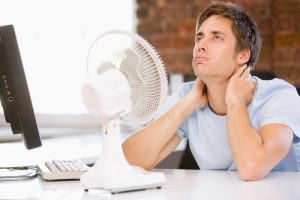 “It’s not so much the heat, it’s the humidity.” Everybody has heard a version of this saying before. People know that when humidity is high, a hot day feels worse. But why does it feel worse? And is an extremely dry day much better? Is there an ideal between too humid and too dry? And what can you do to achieve that ideal in your house?
“It’s not so much the heat, it’s the humidity.” Everybody has heard a version of this saying before. People know that when humidity is high, a hot day feels worse. But why does it feel worse? And is an extremely dry day much better? Is there an ideal between too humid and too dry? And what can you do to achieve that ideal in your house?
Okay, that’s already a lot of questions to ask, and we’d better get to the answers before even more questions pile up. (And if you still have further questions, contact our experts. We’re here to see that you have the best possible help for your air conditioning in Staten Island, NY during the summer.)
Why Is High Humidity a Comfort Problem?
Humidity is the water vapor in the air. When people talk about humidity levels, they’re usually talking about relative humidity, which is a measure of the percentage of water moisture in the air compared to the point where the air would be completely saturated. Relative humidity of 100% means total saturation—and probably rain. If relative humidity is higher than 60%, there is enough moisture in the air to slow down the evaporation of perspiration off of skin. Perspiration is an important way the human body regulates its temperature by releasing heat. If the humidity in the air slows down perspiration, it traps heat, and that makes the temperature feel hotter than it is. An 82°F day can feel like its 90°F.
What about Low Humidity?
When it’s extremely hot outside, people usually welcome dry air: it allows heat to escape more easily from the body, cooling it off. But there’s a downside to low humidity (below 30%): it creates dry skin, itchy eyes, irritated throat, and permits the faster spread of illnesses. Looking forward to the rest of the year, low humidity means colder days feels even worse. You don’t want your home to be too hot or too dry at any time of the year.
What’s the Best Balance for Humidity?
The best relative humidity level for comfort is different from person to person, the same way everyone has different temperature needs. In general, 45% is a good target for balancing humidity between too high and too low.
How Can I Balance Humidity in My Home?
The best way is with a humidifier, dehumidifier, or combination of both. You can purchase portable humidifiers, but we don’t recommend them: they only affect one room at a time and don’t offer much control, often leading to making a room too humid. There are also portable dehumidifiers, but along with their limited range they can be fire hazards.
The best solution is to have a whole house dehumidifier and/or humidifier installed. These systems must be integrated into the HVAC system to work with the heater and air conditioner. You can control them through a humidistat to keep the house at a balanced relative humidity level. Contact our professionals for help with finding out what type of system is best for you. We’ll then take care of the installation that will make sure the system works its best.
Bob Mims Heating & Air Conditioning: Serving Staten Island’s heating and A/C needs since 1955.

